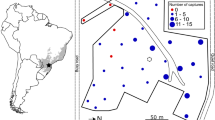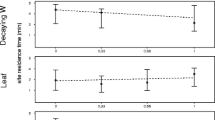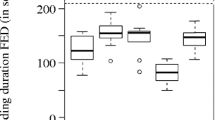Abstract
Socioecological models assume that quality and distribution of food ultimately determine female social relationships: a high quality diet and clumped food distribution should result in the establishment of a hierarchy with stable rank relations which is supported by empirical studies on frugivorous cercopithecines. By contrast, folivorous species with their low quality diet and dispersed food distribution should have egalitarian social relationships but empirical data are very rare. This study on female guerezas of a zoo group aimed to test the models in a colobine species and the results largely agreed with the predictions of the models: facial expressions, vocalizations, and gestures were not used for signalling dominance or subordination. Unritualized aggressions occurred frequently but were of low intensity, and interventions by third parties were never observed. Aggressions were exchanged bidirectionally and this was true also for food stealing and retreats. All this indicated the lack of established rank relations. Allogrooming was distributed rather equally and showed no kin bias. All these features characterize egalitarian social relationships and, hence, support the socioecological models.
Similar content being viewed by others
References
Borries, C. 1993. Ecology of female social relationships: Hanuman langurs (Presbytis entellus) and thevan Schaik Model.Folia Primatol., 61: 21–30.
Borries, C.;Sommer, V.;Srivastava, A. 1991. Dominance, age, and reproductive success in free-ranging Hanuman langurs (Presbytis entellus).Int. J. Primatol., 12: 231–257.
Borries, C.;Sommer, V.;Srivastava, A. 1994. Weaving a tight social net: allogrooming in free-ranging female langurs (Presbytis entellus).Int. J. Primatol., 15: 421–443.
de Waal, F. B. M. 1986. The integration of dominance and social bonding in primates.Quart. Rev. Biol., 61: 459–479.
de Waal, F. B. M. 1989. Dominance ‘style’ and primate social organisation. In:Comparative Socioecology,Standen,V.;Foley,R. A. (eds.), Blackwell, Oxford, pp. 243–264.
de Waal, F. B. M.;Luttrell, L. M. 1989. Toward a comparative socioecology of the genusMacaca: different dominance styles in rhesus and stumptail monkeys.Amer. J. Primatol., 19: 83–109.
Dunbar, R. I. M. 1988.Primate Social Systems. Cornell Univ. Press, New York.
Dunbar, R. I. M. 1991. Functional significance of social grooming in primates.Folia Primatol., 57: 121–131.
Dunbar, R. I. M.;Dunbar, E. P. 1974. Ecology and population dynamics ofColobus guereza in Ethiopia.Folia Primatol., 221: 188–208.
Grunau, T. 1999. Untersuchungen zum Dominanzstil weiblicher Guerezas (Colobus guereza Rüppel 1835). Diploma thesis, Univ. of Bochum, Bochum.
Isbell, L. A. 1991. Contest and scramble competition: patterns of female aggression and ranging behavior among primates.Behav. Ecol., 2: 143–155.
Koenig, A.;Beise, J.;Chalise, M. K.;Ganzhorn, J. U. 1998. When females should contest for food: testing hypotheses about resource density, distribution, size and quality with Hanuman langurs (Presbytis entellus).Behav. Ecol. Sociobiol., 42: 225–237.
Lehner, P. N. 1996.Handbook of Ethological Methods (2nd ed.). Cambridge Univ. Press, Cambridge.
Marler, P. 1969.Colobus guereza: territoriality and group composition.Science, 163: 93–95.
Nicholson, A. J. 1954. An outline of the dynamics of animal populations.Austral. J. Zool., 2: 9–54.
Oates, J. F. 1977. The social life of a black-and-white colobus monkey (Colobus guereza).Z. Tierpsychol., 45: 1–60.
Seyfarth, R. M. 1977. A model of social grooming among adult female monkeys.J. Theor. Biol., 65: 671–698.
Sommer, V. 1985. Weibliche und männliche Reproduktionsstrategien der Hanuman-Languren (Presbytis entellus) von Jodhpur, Rajastan/Indien. Ph.D. diss., Univ. of Göttingen, Göttingen.
Sterck, E. H. M.;Watts, D. P.;van Schaik, C. P. 1997. The evolution of female social relationships in nonhuman primates.Behav. Ecol. Sociobiol., 41: 291–309.
van Hooff, J. A. R. A. M.;van Schaik, C. P. 1992. Cooperation in competition: the ecology of primate bonds. In:Coalitions and Alliances in Humans and Other Animals,Harcourt,A. H.;de Waal,F. B. M. (eds.), Oxford Univ. Press, Oxford, pp. 357–389.
van Schaik, C. P. 1983. Why are diurnal primates living in groups?Behaviour, 85: 129–143.
van Schaik, C. P. 1989. The ecology of social relationships amongst female primates. In:Comparative Socioecology,Standen,V.;Foley,R. A. (eds.), Blackwell, Oxford, pp. 195–218.
Wrangham, R. W. 1980. An ecological model of female-bonded primate groups.Behaviour, 75: 262–299.
Author information
Authors and Affiliations
About this article
Cite this article
Grunau, T., Kuester, J. Dominance style in female guerezas (Colobus guereza Rüppell 1835). Primates 42, 301–307 (2001). https://doi.org/10.1007/BF02629621
Received:
Accepted:
Issue Date:
DOI: https://doi.org/10.1007/BF02629621




